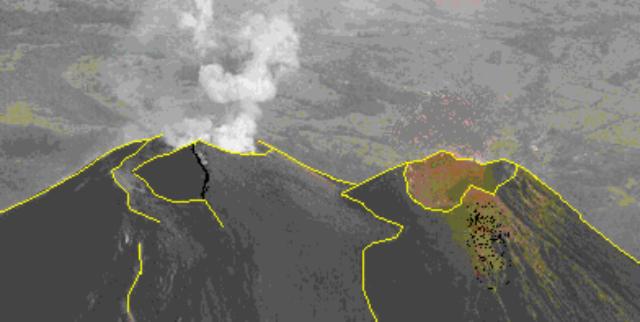Report on Arenal (Costa Rica) — March 1999
Bulletin of the Global Volcanism Network, vol. 24, no. 3 (March 1999)
Managing Editor: Richard Wunderman.
Arenal (Costa Rica) Eruptions increase in volume and number during February
Please cite this report as:
Global Volcanism Program, 1999. Report on Arenal (Costa Rica) (Wunderman, R., ed.). Bulletin of the Global Volcanism Network, 24:3. Smithsonian Institution. https://doi.org/10.5479/si.GVP.BGVN199903-345033
Arenal
Costa Rica
10.463°N, 84.703°W; summit elev. 1670 m
All times are local (unless otherwise noted)
This report covers August 1998 through March 1999. Early in this interval a small dome grew at a point adjacent and S of Crater C's lava vent; during September the dome reached ~10-m tall. Figure 88 shows Arenal's summit topography in April 1998.
The volume and number of explosive eruptions in April 1999 diminished with respect to February, continuing a trend of decreasing activity going back to late 1998. Lava pulses first emitted during December traveled down the N flank and during February made it to 1,200 m elevation. Others descended the NE flank; since April 1998 lavas traveling in other directions have been absent. During January through April ash columns rarely rose more than 500 m.
Also during January-April, EDM surveys detected a contraction of 20 ppm/year; tiltmeters measured a deflation of 7-10 µrad/year. Seismic data transmission problems plagued the local station (VACR) during August, September, March, and April. Seismically detected eruptions registered between 48 and 473 times a month. Tremor prevailed for between 25 and 120 hours a month.
Despite ongoing Strombolian eruptions venting adjacent to Arenal's summit at crater C during 1999, there occurred no measurable gain in summit height. Most pyroclastic material entered channels and descended the summit area. As is typical, crater D remained fumarolically active.
Acid rain most strongly affected the flanks on the NW, W, and SW. Rainwater chemistry collected at station Cáracava for January 1997 through September 1998 showed these variations: pH, 3.4- 4.5; SO4 ion, ~2-13 mg/L; Cl ion, ~3-27 mg/L. For both 1997-98, peaks in pH appeared during September; similarly, peaks in the two ions appeared in the first half of the year (during the months January-May). The chlorine ion in rainwater was enriched compared to rainwater collected at Poás, a case where degassing occurs though a substantial crater lake that is thought to absorb a large portion of the fumarolic HCl.
Geological Summary. Conical Volcán Arenal is the youngest stratovolcano in Costa Rica and one of its most active. The 1670-m-high andesitic volcano towers above the eastern shores of Lake Arenal, which has been enlarged by a hydroelectric project. Arenal lies along a volcanic chain that has migrated to the NW from the late-Pleistocene Los Perdidos lava domes through the Pleistocene-to-Holocene Chato volcano, which contains a 500-m-wide, lake-filled summit crater. The earliest known eruptions of Arenal took place about 7000 years ago, and it was active concurrently with Cerro Chato until the activity of Chato ended about 3500 years ago. Growth of Arenal has been characterized by periodic major explosive eruptions at several-hundred-year intervals and periods of lava effusion that armor the cone. An eruptive period that began with a major explosive eruption in 1968 ended in December 2010; continuous explosive activity accompanied by slow lava effusion and the occasional emission of pyroclastic flows characterized the eruption from vents at the summit and on the upper western flank.
Information Contacts: E. Fernández, V. Barboza, M. Martinez, E. Duarte, R. Sáenz, E. Malavassi, R. Van der Laat, E. Hernández, and T. Marino, Observatorio Vulcanologico y Sismologico de Costa Rica, Universidad Nacional (OVSICORI-UNA), Apartado 86-3000, Heredia, Costa Rica; Wendy Perez Fernandez, Seccion de Seismologia, Vulcanologia y Exploracion Geofisica, Escuela Centroamericana de Geologia, Universidad de Costa Rica, POB 35-2060, San José, Costa Rica.


